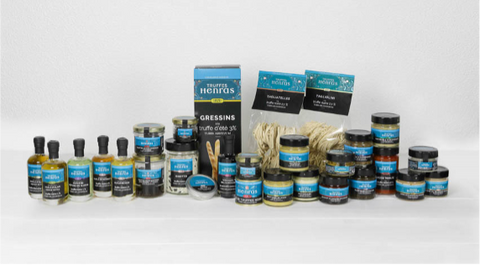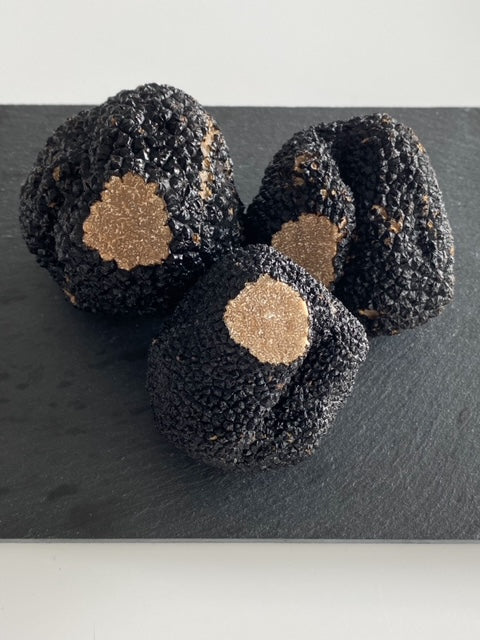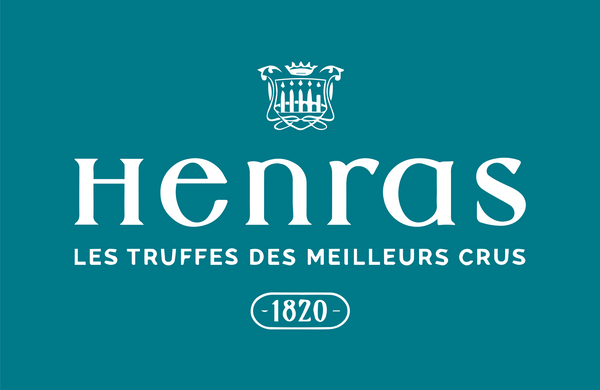Nowadays, the truffle is experiencing a real fashion effect. More and more restaurateurs, businesses and grocery stores are selling it in different forms. It happens that true taste is highlighted and respected, but often it is distorted and overused. The truffle is an exceptional dish, so it is much easier to reproduce its flavor than to obtain a quality product. The problem resulting from these practices is the habituation of the palate to the aroma. In this article, we try to answer all your questions about black diamond and the abuse of aroma products.
THE TASTE OF FRESH TRUFFLE
The black truffle is a delicacy that cannot be cultivated, which is why it is a precious and rare delicacy. Its production is impacted by the climate and its harvest extends over a period of 16 weeks between November and the end of March. From one year to the next, the harvests are not identical in terms of quantity and taste quality. Even within the season, the organoleptic characteristics of the black truffle vary. The one harvested at the beginning will not have the same flavors as one harvested at the height of the season. To enjoy the best subtle and powerful flavors of black diamond , it is recommended to buy it at the end of January.
FIRST BOILING PRESERVES
The 1st boiling preserves from Maison Henras are made from fresh, peak-season truffles . The latter undergoes a single heat treatment, which preserves a large part of these fragile aromatic compounds. It loses weight when cooked, allowing it to produce a fabulous black truffle juice made 100% from tuber melanosporum . These preserves are only composed of the black, raw, whole diamond and nothing else.

Despite the use of beautiful fresh truffles to make these, we obtain a different preserve from this one. The advantage of the latter is that they go well with any type of preparation. In fact, part of the aromatic bouquet of fresh black truffle is transformed, to give more marked aromatic notes of leather, mushroom and meat, making it very interesting taste- wise.
DERIVED PRODUCTS AND ARTIFICIAL FLAVORS
Nowadays, the taste is more and more overused. Indeed, consumers' growing habit of overly powerful artificial flavors in truffle -derived items distorts the perception of the raw product.
The majority of derivative items found on the market are made from summer truffle , which loses all its flavor when it undergoes a thermal transformation process. The aromatic bouquet is replaced by synthetic aromas which caricature, amplify but do not correspond to the true aromatic bouquet of the Périgord diamond.
In the majority of cases, lovers of truffle products like… the synthetic aroma, and not that of real truffle.
Some tips for choosing them wisely:
- Favor those with black truffle and avoid those with summer truffles, which have no taste interest when they have been cooked,
- Prefer items made in France
- Read the composition of the articles and avoid those mentioning “flavors” in the list of ingredients.
- On cheeses, such as “brie with truffle”, buy them at the peak of the black truffle season and make sure that they do not contain any additives.

DID YOU KNOW ?
According to Decree No. 2012-129 of January 30, 2012 relating to the marketing of truffles and foodstuffs:
 The mention: "truffled" is reserved for articles containing a minimum of 3% truffle belonging to the Tuber Melanosporum, Brumale and Magnatum species.
The mention: "truffled" is reserved for articles containing a minimum of 3% truffle belonging to the Tuber Melanosporum, Brumale and Magnatum species.
The name of the article must be composed of the name of the species of truffle used in its composition.
The words: “with truffle juice” or “flavored with truffle juice” are reserved for items containing a minimum of 3% juice from the Tuber Melanosporum and tuber brumale varieties.
The name of the proposed item must mention the name of the species of truffle used to obtain the juice. When flavorings are also used, the name of the flavorings included in the composition is indicated in the name of the article.
SURROUNDED BY SYNTHETIC FLAVORS
Furthermore, artificial (or synthetic) flavors are widely used in the food industry to imitate the taste and compensate for the lack of aromatic bouquet of summer truffles. They cannot fully reproduce the complexity and subtlety of the aromatic bouquet of fresh truffles but they appeal to a large number of consumers. The problem is that they alter their palate , accustoming them to a false reality. The synthetic aromas used do not reproduce the aromatic bouquet of black truffle but rather that of Alba which has an alliaceous aroma and aromatic bouquet.
The black truffle owes its subtlety to the fact that it contains nearly fifty natural aromatic molecules which develop during its maturity cycle in the soil. Synthetic flavors, for their part, are made from 4 or 5 basic molecules, which also come from petrochemicals. The synthetic aroma therefore caricatures the aromatic subtlety achieved by nature and becomes only a pale copy of reality.
THE RANGE WITHOUT HOUSE AROMA HENRAS
To celebrate its 201st anniversary, Henras has decided to offer a new, unique generation of truffle products which:
- Contain black truffle from Périgord (up to 6%),
- Are made without added flavoring .
 Henras, in accordance with its values, has chosen to promote the authentic taste of the Périgord diamond , which, when it is well chosen and then cooked, sublimates the flavors , as all chefs know.
Henras, in accordance with its values, has chosen to promote the authentic taste of the Périgord diamond , which, when it is well chosen and then cooked, sublimates the flavors , as all chefs know.
To accomplish this feat, Henras worked on the basis of a new process allowing it to be dried while preserving a significant part of its volatile odorous biochemical molecules . The truffle powder obtained mixes ideally with salt, but also with all fatty supports (butter, oil, etc.) and thus allows implementation without addition, simply based on materials dried.
For its spreads, Henras worked (in partnership with a fellow artisan) from particularly aromatic black truffles and concentrated black truffle juice , to infuse the ingredients of the preparations. This allowed him to develop an artichoke spread, a French cheese cream (Comté and Reblochon) and a “Belle époque” pâté with duck foie gras, incorporating 5% black truffles from Périgord.
TRUFFLE IS AN ART
Appreciating the taste of truffle is a long learning process, which requires training, but which also calls upon the memory of the aromatic bouquet just like learning the grape varieties of a wine.
It can be considered a condiment or a spice. It is there to enhance the preparations with which it is associated. Indeed, it is a natural flavor enhancer like the fifth flavor, “Umami” which comes to us from Japan. This item is deep and complex, and it holds in the mouth to leave a lingering sensation. We find it in French gastronomy with our sauce bases or our broths.
Truffle is an excellent ally in sauces, and chefs love to enhance their preparations by using it.
It is complex, you have to learn to appreciate it, just like wine, it is about educating your palate. It's a long road, but once you've made the effort, a culinary paradise awaits you.
THE KNOW-HOW
At Henras , every week, we select the best batches of truffles to allow our customers to benefit from the best that nature has to offer. We favor quality over quantity by receiving the truffles in the ground to ensure perfect quality after cleaning. Our truffles are cleaned and sorted by hand, to extract only excellence and satisfy the expectations of our prestigious clientele. Our range of products does not contain any artificial flavors , and we seek to create gourmet preparations that enhance the true aromatic bouquet of the truffle .


